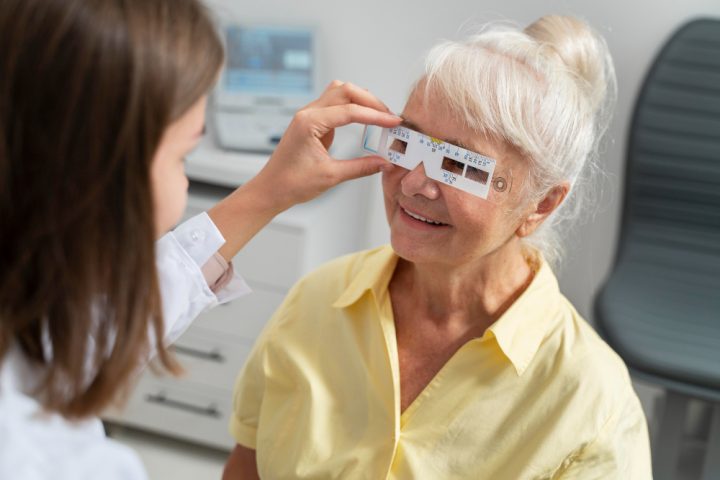
June marks Cataract Awareness Month, a vital time to raise awareness about one of the leading causes of vision impairment worldwide. Cataracts, which cause the eye’s natural lens to become cloudy, can gradually blur vision & interfere with everyday activities. While they are especially common among older adults, the important message is that cataracts are both detectable & treatable. With timely diagnosis & a simple surgical procedure, most people can regain clear vision. This month is a great opportunity to learn more, get regular eye check-ups & encourage others to take steps toward protecting their sight.
What are cataracts?
A cataract is the clouding of the eye’s natural lens, which is normally clear, leading to blurred, hazy, or dim vision—often described as seeing through a foggy window. This occurs when proteins in the lens break down & clump together, scattering light & preventing it from focusing properly on the retina. Cataracts typically develop gradually & may not affect vision noticeably at first. However, if left untreated, they can progress over time & eventually cause serious vision loss or even blindness.
Who is at risk?
Cataracts can develop in anyone, but certain individuals are more likely to be affected due to specific risk factors. These include:
• Older age – Most cataracts occur in people over the age of 55.
• Diabetes – High blood sugar can lead to changes in the eye’s lens, increasing the risk. • Family history – Genetics can make some people more susceptible.
• Smoking – Tobacco use accelerates lens degeneration.
• Prolonged exposure to sunlight – UV rays can damage the lens over time, especially without proper eye protection.
• Past eye injuries or surgeries – Trauma or procedures can lead to earlier cataract development.
• Heavy alcohol consumption – Can contribute to oxidative stress in the eye.
• Chronic use of steroid medications – Long-term use of corticosteroids may promote cataract formation.
• Obesity – Often associated with other health conditions that impact eye health. • High blood pressure – May indirectly contribute to lens changes.
Understanding these risk factors & having regular eye check-ups can help with early detection & effective treatment of cataracts.
The Importance of Early Cataract Detection
Regular eye exams are essential for spotting cataracts in their early stages. Early identification enables your ophthalmologist to monitor changes closely and suggest timely, effective treatment before the condition significantly impacts your vision.
Benefits of Early Cataract Treatment
Detecting and treating cataracts early. often through surgery, offers several significant advantages. Here’s why early intervention matters:
• Sharper Vision, Sooner
By replacing the clouded natural lens with a clear artificial one, cataract surgery can dramatically restore vision. With modern techniques, the procedure is highly accurate, safe and typically involves minimal discomfort.
• Quicker Recovery
Today’s cataract procedures are designed for faster healing. Most patients notice clearer vision just days after surgery.
• Customized Vision Correction
Advanced intraocular lenses (IOLs) not only remove cataracts but can also address issues like astigmatism and presbyopia, potentially reducing or eliminating the need for glasses or contact lenses.
• Lasting Visual Clarity
Cataract surgery offers long-term benefits. Many patients enjoy clear, improved vision for years, leading to greater independence and a better quality of life.
How Cataracts Are Diagnosed?
Diagnosing cataracts involves a detailed eye examination along with a review of your medical history and symptoms. Your eye specialist may perform several key tests to confirm the presence and extent of cataracts
• Vision Test: Measures how well you can see using an eye chart.
• Slit-Lamp Exam: Uses a special light to examine the front parts of your eye in detail. • Retinal Exam: Involves dilating your pupils to check the back of your eye for cataracts. • Eye Pressure Test: Measures fluid pressure inside the eye to rule out other conditions like glaucoma.
Early diagnosis helps ensure timely & effective treatment.
What are the treatment options?
The only effective treatment for cataracts is surgery. When glasses no longer improve vision, cataract surgery becomes necessary. During the procedure, your clouded natural lens is removed & replaced with a clear intraocular lens (IOL). This artificial lens stays in your eye permanently & can also correct vision problems like nearsightedness or astigmatism.
Cataract surgery is typically done on an outpatient basis under local anesthesia. Most people recover within a few weeks. If both eyes need treatment, the surgeries are scheduled separately. While the procedure is generally safe, there are small risks such as infection, bleeding, or retinal detachment. In rare cases where an IOL isn’t suitable, glasses or contact lenses may be used to restore vision.
Cataract surgery offers long-lasting improvement & can significantly enhance your quality of life.
Take action this cataract awareness month
This Cataract Awareness Month, take a proactive step toward protecting your vision. Early detection and timely treatment can make all the difference in preserving your sight & maintaining a high quality of life. Don’t wait for symptoms to worsen – schedule a comprehensive eye exam, stay informed & encourage your loved ones to do the same. Clear vision begins with awareness & action.
